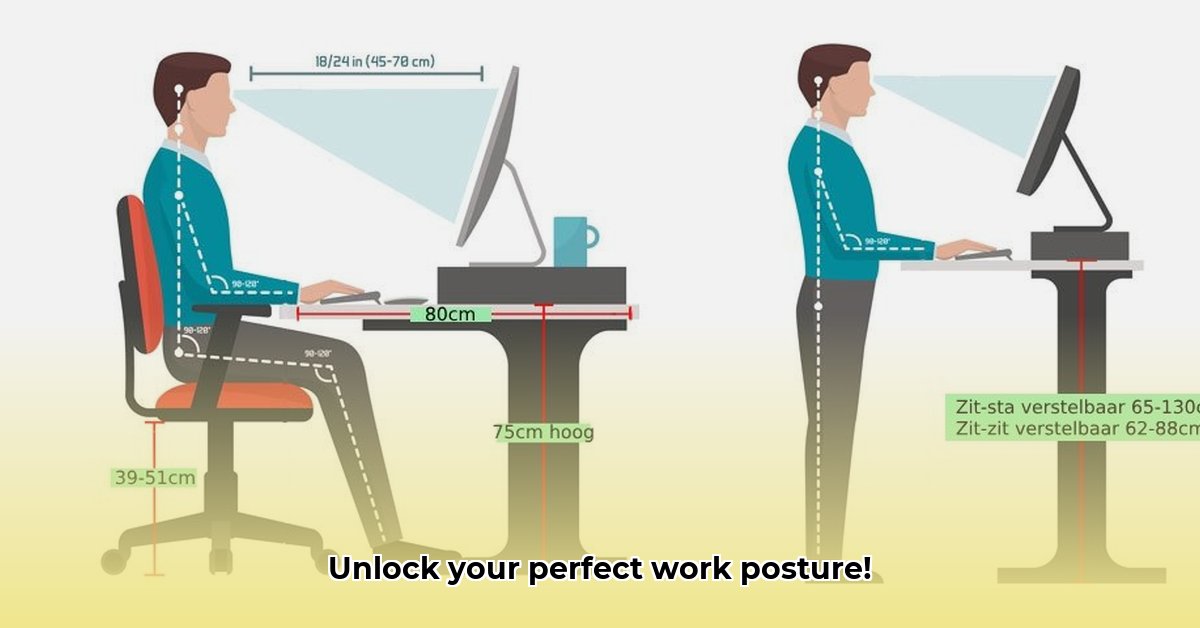
Suffering from rugpyn? Spending hours slumped over your desk? Finding the ideale hoogte bureau (ideal desk height) is key to a healthier, more productive workday. This guide provides a simple, step-by-step plan to ditch the backache and boost your comfort. We’ll cover measuring your ideal height, fixing your current setup, choosing a new desk, and other ergonomic essentials. Let's get you working smarter, not harder!
Measuring Your Ideal Desk Height
The perfect desk height is personal. Here's how to find yours:
Step 1: Perfect Posture Prep: Sit comfortably in your chair with your feet flat on the floor (or on a footrest). Adjust your chair until your hips are level and your knees bent at roughly 90 degrees. This is your base posture.
Step 2: Natural Arm Position: Let your arms hang relaxed by your sides. Avoid straining or forcing a position – natural relaxation is key.
Step 3: The Elbow Measurement: Measure the distance from the floor to the bottom of your elbows. This is your approximate ideal desk height.
Step 4: Fine-Tuning for Typing: For many, optimal typing height is slightly lower than the elbow measurement. While seated with relaxed arms, aim for forearms parallel to the floor while typing. Try both heights and choose what feels most comfortable for you. A difference of 2-3cm is typically within the acceptable range.
Step 5: Desk Height Chart (Approximate): This chart gives a guideline, but your individual measurements are crucial.
| Height (cm) | Suggested Desk Height (cm) |
|---|---|
| 150 | 62-65 |
| 155 | 64-67 |
| 160 | 66-69 |
| 165 | 68-71 |
| 170 | 70-73 |
| 175 | 72-75 |
| 180 | 74-77 |
| 185 | 76-79 |
| 190 | 78-81 |
| 195 | 80-83 |
| 200 | 82-85 |
Important: These are suggestions. Your ideal height may differ slightly. Prioritise sustained comfort. Don't hesitate to adjust based on your personal experience.
What if You Can't Change Your Desk Immediately?
Don't worry! Temporary solutions are available:
- Footrests: If your desk is too high, a footrest helps maintain correct posture, keeping feet flat and preventing strained knees.
- Books or Blocks: For low desks, temporarily raise your chair using sturdy, stable books or blocks. This is a short-term measure only. Ensure they are stable to avoid accidents.
Choosing the Right Desk: A Long-Term Investment
An adjustable desk is a worthwhile investment. Consider:
- Electric vs. Manual: Electric desks adjust with a button; manual ones are more affordable.
- Size: Measure your workspace before buying.
- Weight Capacity: Choose a desk that can comfortably support your equipment. Quality matters!
Beyond Desk Height: Ergonomics for a Complete Setup
Desk height is only part of the equation. Optimise your whole setup:
- Monitor Placement: Center your monitor at or slightly below eye level, about an arm's length away.
- Keyboard and Mouse: Keep your wrists straight and avoid reaching.
- Regular Breaks: Stand, stretch, and move every 30-60 minutes to prevent stiffness and strain. This improves circulation and energy levels, promoting wellbeing. A 5-minute stretch break every hour is recommended to prevent musculoskeletal disorders.
Troubleshooting Common Problems
Persisting pain?
- Re-evaluate your setup: Double-check all elements: desk height, monitor, keyboard, mouse position. It’s all connected!
- Seek professional help: Consult a physiotherapist or ergonomist for a personalized assessment and recommendations.
Risk Assessment Matrix: Protecting Your Well-being
This matrix highlights potential risks and mitigations.
| Risk Factor | Likelihood | Impact | Mitigation |
|---|---|---|---|
| Incorrect Desk Height | High | High | Adjust desk to correct height; follow this guide! |
| Poor Posture | High | Medium | Improve posture, take regular breaks |
| Musculoskeletal Disorders (MSDs) | High | High | Correct desk height, posture, & regular breaks |
| Eye Strain | Medium | Low | Proper monitor placement |
| Carpal Tunnel Syndrome | Low | Medium | Ergonomic keyboard and mouse; regular breaks |
Finding your ideale hoogte bureau is an investment in your health and productivity. Prioritise your well-being—your body will thank you!